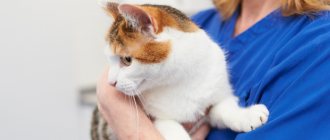What is cat scabies?
Cat scabies is an animal skin disease caused by parasitic organisms. The disease is caused by these types of ticks:
- Sarcoptes canis. The organisms cause pruritic scabies (sarcoptic mange). The locations of the lesions are different parts of the body. The disease most often affects dogs, but cases of infection in cats are also not uncommon.
- Notoedres cati. Mites cause head scabies (notoedrosis). This cat disease is one of a number of common diseases.
Important! The disease also occurs due to ear mites. Scabies in this case is called otodectosis.
Scabies mites under a microscope
Ticks that live in your pet's skin cause discomfort, which forces the cat to scratch the lesions. Symptoms of the disease become apparent 2-3 weeks after infection.
Carnivore notoedrosis
Carnivore notoedrosis
The causative agent is Notoedres cati ticks (family Sarcoptidae).
Morphologically they are similar to mites of the genus Sarcaptes. The body of sexually mature individuals is round, dirty gray in color, measuring (0.14...0.45) x (0.12...0.4) mm. The proboscis is horseshoe-shaped. The legs are short, thick, cone-shaped. They live and reproduce in the thickness of the epidermis.
Epizootological data. Infection occurs through contact of sick animals with healthy ones or through infested objects (in fur farming - through cages, houses, nests, feeders, equipment). The disease usually occurs in late autumn and spring. In cats and dogs it occurs sporadically due to separate keeping, and among fur-bearing animals it can become widespread, especially when kept in groups. Notoedrosis affects animals of different ages and breeds, but young ones are more susceptible, and the disease is more severe in them. Notoedrosis also occurs in laboratory animals: rabbits, rats and mice, guinea pigs.
Symptoms of the disease. The usual places of initial settlement of notoedrosis mites are the scalp, lips, bridge of the nose, forehead, bases of the ears, auricles, and skin around the eyes. From here, mites can spread to other parts of the body, but mainly to the skin of the front and less often the hind legs.
The disease is manifested by severe inflammation of the skin and the formation of thick gray-yellow crusts. As a result of scratching, individual crusts merge with each other and extensive, dense folded deposits are formed. The skin becomes rough, inelastic, with many folds. Hair falls out. In severe cases, the eyelids swell, purulent conjunctivitis develops, the nasal openings narrow and breathing becomes difficult. In dogs, sometimes the painful process is concentrated on the lower wall of the abdomen, and in cats, the paws are also affected at the same time as the head. The disease develops after 2-3 months. takes a generalized form and ends fatally.
Diagnostics. The diagnosis is confirmed by the results of acarological examination of skin scrapings.
Treatment. Before treatment, lesions in animals are first softened using fish oil, oil or warm acaricidal emulsions.
For the treatment (and prevention) of fur-bearing animals and rabbits with sarcoptic mange and notoedrosis, acaricidal baths are used. Animals are bathed by immersing them in liquid (30-32 °C), leaving only their heads on the surface. To avoid being bitten, the animal's muzzle is tied. Two workers fix the legs and ears, and the third, massaging with stroking, helps to wet the hair. The head is immersed in the liquid at least twice, squeezing the nostrils and oral cavity with the palm of the hand. After bathing, the fur is wrung out on a rack and the animals are placed in a warm, ventilated room.
Cats with extensive lesions are treated by rubbing in an oil-based acaricide; less extensive lesions are treated with aqueous emulsions of acaricides. It is advisable to bathe or dry dogs. Licking of drugs is prevented using a cervical collar.
All cats are clean, so why notoedrosis in cats? They groom themselves constantly, sometimes for an hour or more, and maintain personal hygiene. However, despite this, pets are often tormented by fleas or lice, which irritate the skin, causing uncontrollable scabies. However, often the problem turns out to be much more serious than just fleas, which many fight against with collars or special shampoos.
Notoedrosis or otherwise “Cat scabies” often causes serious consequences and problems if not treated in a timely manner. The peculiarity of the disease is that it affects animals of any age and breed, and the most striking symptoms, which cannot be ignored, appear only at a late stage, when it is even more difficult to cure the pet. The disease is also harmful to human health.
In this article we will look at the disease in general and how it occurs, as well as the main symptoms and treatment methods. Of course, all information provided is for informational purposes only. Under no circumstances should you engage in diagnosis, much less treatment, on your own. In this situation, only calling a veterinarian to your home helps. This is due to the fact that the cat will experience unnecessary stress from the trip to the clinic, and will also endanger everyone around it, because notoedrosis is contagious.
Ways of infection with notoedrosis in cats
Cat scabies is a contagious disease. Ticks can penetrate your pet's skin after these manipulations:
- Contact with an infected animal. Harmful organisms are easily transferred from one pet to another. This often happens on the street, at exhibitions, in pet stores, veterinary offices and nurseries.
- Contact with an infected person. Ticks easily move from cat to cat and from pet to person.
Important! An animal can also become infected through domestic means. For example, after using a hair brush that got ticks from a sick cat. Carpets, bedding and floor coverings are items that can also temporarily harbor parasites.
Cat affected by notoedrosis
The younger the animal is, the more susceptible it is to infection. The highest risk group includes young individuals.
Treatment of cats
If the diagnosis is confirmed based on diagnostics, the pet remains in the veterinary clinic, where it is isolated in a separate room. Treatment is carried out through conservative therapy and consists of the following stages:
- in the affected areas, the cat's fur is carefully trimmed;
- the animal is bathed with special products that have exfoliating and acaricidal effects;
- then therapy is carried out using systemic and local antiparasitic drugs.
The course of treatment is repeated several times, this is necessary in order to kill mature individuals and then parasites hatching from clutches of eggs. Pet owners should treat all surfaces at home that the cat has come into contact with, replace items it uses, and carry out antiparasitic prevention for other pets (even if they are healthy).
Good to know!
The tick lives on a cat's body for up to 8 weeks. However, when released into the external environment, the lifespan of these mites is significantly reduced.
At an ideal temperature of 7 to 10 C, the parasite can live no longer than 10 days. If environmental conditions turn out to be less favorable, this figure decreases significantly.
Preventive actions
To protect your pet from parasites and prevent the development of notoedrosis, you must adhere to the following recommendations:
- limit your pet's visits to the street;
- avoid contact with other animals living outside the home;
- if the cat walks outside, regularly treat it with preventative agents against parasites;
- Provide your pet with a nutritious diet to increase the body’s defenses.
When in contact with sick cats, you should observe the rules of personal hygiene, as mites can penetrate human skin, causing allergic inflammation.
Can a person get notoedrosis from a cat?
The tick can “move” from the pet to the owner, but will not be able to reproduce on the human body. Scabies in humans caused by cat mites goes away within about a month after the first symptoms if left untreated. The use of medications significantly speeds up the healing process.
A treatment regimen should be drawn up with a dermatologist. Typically, a specialist recommends topical medications that eliminate itching and have a detrimental effect on mites. In some cases, medications are prescribed for internal use.
A tick can “move” from a cat to a person
Attention! Despite the fact that notoedrosis goes away without treatment, you should not ignore a visit to the doctor. There is a high risk of mutation and negative consequences after the course of the disease.
Treatment
Attention!
In the absence of proper treatment, the disease will progress, suppress the immune system and can cause complications in the form of necrosis and necrosis of the skin.
Do not self-medicate under any circumstances and be sure to show your cat to a veterinarian. He will conduct the necessary research and prescribe effective treatment.
For the disease notoedrosis, various ointments, gels (containing sulfur), bathing in medicinal solutions and washing with medicated shampoos are prescribed.
If the case is advanced and there are purulent foci, the veterinarian will also prescribe an antibiotic and sedatives.
- First, the animal must be isolated so as not to spread pathogens.
- Long hair around ulcers and wounds is carefully trimmed. This is necessary to facilitate access to the affected areas.
- To treat the affected areas, you need to prepare the animal's skin (wash with warm water and soap and remove the crusts).
- The medicine must be applied with gloves, with some kind of spatula or stick.
In the fight against scabies mites, the following drugs have proven themselves to be best:
- “Demos” (used 5 times, a break of 4 days is maintained between each use)
- “Aversectin ointment” (applied only twice, the break between applications is 7 days);
- “aqueous emulsion of neocidol” (used in the same way as “aversectin ointment”).
In addition to the listed medications, you can use Ivermek, sulfur ointment (15 or 20%), and Stronghold.
Important!
Do not use the presented medications for cats under six months of age. Under no circumstances should drugs intended for dogs be used for treatment.
The therapeutic course, in the case of “cat scabies,” can last up to eight weeks. This duration is due to the fact that the drugs do not kill tick eggs and have a detrimental effect only on mature individuals. Remember, the sooner the disease is detected, the faster it can be cured.
Symptoms
A number of clinical signs are characteristic of feline scabies:
- Itching . The animal itches, bites itself, rubs against objects. His behavior becomes restless.
- Papules with a crust . These changes in the epidermis are a consequence of the presence of ticks in it.
- Peeling . The scratched skin becomes covered with crusts. It becomes thicker, folds appear on it.
- Baldness . The hair on the combed areas gradually falls out.
Itching in a cat is one of the signs of notoedrosis.
If left untreated, notoedrosis turns into sarcoptic mange, that is, not only the head, but also the entire body of the pet is affected. The following are possible serious complications:
- Loss of appetite . The animal's body is exhausted. The pet may also refuse water.
- Infection . A cat can acquire other serious diseases through the entry of pathogens through breaks in the epidermis.
- Rotting of the skin and damage to other organs . The prognosis for treatment after these changes is rarely favorable.
Important! If you do not treat an animal that is actively developing notoedrosis, it will quickly die.
A cat with advanced stages of notohedrosis
Causative agent of notohedrosis
Notoedrosis is a pathological process, also known as mange, that affects cats.
The disease is known for its high degree of contagiousness (among animals), as well as its severe course. If not treated in a timely manner, it can lead to the development of severe complications. Notoedrosis causes a lot of unpleasant sensations for the animal and causes severe skin itching. In cats, notoedrosis belongs to the group of parasitic pathologies. The development of this type of scabies occurs when an animal is infected with a special type of mite – Notoedres cati.
It is important to know!
Coming into contact with the cat’s body, getting onto the fur and then into the skin, the parasite moves to the neck and head area.
In these areas of the body, the tick makes passages in the deep layers of the dermis, feeding on the blood and particles of the pet’s skin.
Regarding the physiology of the parasite, it is a microscopic life form. Even with a high tick population and obvious symptoms of disease in an animal, it is almost impossible to detect ticks with the naked eye.
The life cycle of a tick is limited to approximately 6-8 weeks, but only if it has a comfortable habitat, which in this case is the body of a cat. During this period, the female tick can lay up to 50 eggs. New individuals hatching from laid eggs require no more than 18 days to reach maturity and begin breeding.
Interesting fact!
First of all, ticks are contagious to other animals; they can infect cats and dogs; notoedrosis is especially severe in small rodents (guinea pigs, hamsters).
Human infection is also possible; in this case, the parasite causes pseudoscabies; the disease is accompanied by severe itching and skin irritation.
Sources of parasite infection
The transmission routes of notoedrosis coincide with other types of parasitic pathological processes. In this case, we must not forget that Notoedres cati is capable of surviving for some time in the environment, outside the host’s body.
Among the main sources of infection among cats, veterinarians identify:
- when a cat comes into contact with another animal that has notoedrosis or is a carrier of parasites (this route of infection is the most likely);
- upon contact with objects that a sick animal has previously been in contact with (comb, collar, bedding, pieces of furniture, etc.);
- environment - this method of infection is the least common, but ticks can still be found in outdoor conditions, especially where a sick animal has recently been located.
Diagnostics
Diagnosis of scabies in cats involves a number of stages:
- Initial home inspection . The owner needs to assess the pet’s condition and identify the presence of all symptoms of the disease.
- Initial examination by a specialist. The veterinarian examines the pet without the use of special laboratory equipment.
- Laboratory research . The veterinarian takes a scraping from the cat's skin to examine it under a microscope.
Attention! Trial treatment also refers to diagnostic methods. It is especially relevant at the beginning of the development of the disease. Its essence is monitoring the cat’s condition during its treatment with standard medications.
Examination of scrapings from the skin of a cat
In most cases, diagnosing notohedrosis is a quick process, as the parasites are very easy to detect. It is especially easy to make an accurate diagnosis during the progression of the disease.
Symptoms
Mostly young cats get sick. First, an exhausting itching begins on the outer surface of the ear. Hair falls out on the affected areas. The pathology spreads, covering the eyelids, then the entire face and neck of the cat. In advanced cases, insects move to the belly. This is due to the habit of cats sleeping curled up in a ball.
The skin thickens, wrinkles, and becomes covered with grayish-yellow crusts. Constant scratching of the itchy surface leads to infection with secondary microflora, which always lives on the cat. Local lymph nodes become hypertrophied. The skin cracks and is re-infected with opportunistic microflora.
Notoedrosis in advanced form
Treatment methods
Treatment of notoedrosis in cats is a scheme of several stages. Each of them has its own characteristics, which have a beneficial effect on the pet’s condition and prevent the progression of the disease. Before using medications, you should consult your veterinarian.
Before treatment, be sure to consult a veterinarian
Preparatory stage
In order for medications to be as effective as possible, several preparatory procedures need to be carried out:
- Washing a cat with anti-seborrhea shampoo. This action is necessary to remove dead skin particles and disinfect it. Shampoo must be purchased in special stores with goods for animals.
The most common remedies against soberia in cats
- A haircut . The manipulation prevents the formation of wounds when removing matted hair from animals. It also makes it easier to apply topical medications. The procedure is especially necessary for cats with long hair.
- Removing crusts with tweezers . Large dead skin particles should be removed to prevent the animal from biting or scratching itself. You need to act as carefully as possible so that the cat does not injure itself on the tweezers or bite a person in self-defense.
Places under which there was a crust must be treated with disinfectant compounds (potassium permanganate solution, etc.).
Local therapy
Topical products eliminate itching, act directly on mites, disinfect and improve the condition of the epidermis. The table shows drugs suitable for the treatment of notoedrosis and methods of their use.
| Medicine | Image | Mode of application |
| "Spot-on" | Apply to the withers once every 2 weeks. Duration of the course – from 2 months until complete recovery | |
| "Stronghold" | The product is applied once a day to the affected areas until recovery | |
| "Fosmet" (0.09%), "Amitraz" (0.05%) | Lesions are treated with drugs 3 times a day for 2 weeks |
Attention! When applying the compositions, you should avoid the mucous membranes and the oral cavity. Getting the medicine into your eyes is especially dangerous. If the medication gets into the mouth or eyes, it is necessary to rinse these areas of the pet.
Systemic therapy
Systemic treatment products are used only after consultation with a veterinarian, since their improper use is dangerous to the cat’s health. Before prescribing them, the specialist assesses the pet’s condition and determines the presence of possible contraindications.
Ivermectin is a suitable drug. It is used as an injection. The duration of the course and dose are determined by the veterinarian.
Step-by-step instructions for treating notohedrosis in cats
Adjuvant therapy
When a pet gets sick, its immunity is significantly reduced. To increase the protective properties of the body, the cat needs to be given balanced healthy food, vitamin and mineral complexes and feed sulfur.
If your cat is restless and constantly itching, you can help her with sedatives. A suitable medicine is Prednisolone. Directions for use: half a milligram per day. Course – 3 days.
Disinfection of the habitat
It is better to replace cat rugs and bedding. You can also wash them in hot water with disinfectants. Until your pet recovers completely, you need to wash the floors daily with water and insecticides. It is advisable to remove carpets.
Video - Subcutaneous mites in cats
Symptoms of notohedrosis
- Since the disease is caused by scabies mites, it is already clear that the main symptom of notoedrosis in cats is itching. And this happens because mites first gnaw through the epidermal layer, and then make passages under it. And that is why the animal begins to itch.
- If you look closely at the muzzle, ears, tummy and groin area, you will first notice bubbles on the skin, which after scratching become covered with crusts. The animal, scratching with its paws, injures itself.
- Another symptom of notohedrosis in a cat is hair loss (especially in areas with crusts).
- If treatment for a cat with notoedrosis is not started in time, the parasites will “attack” the entire body. The skin will thicken, dry out and crack. And cracks are wounds, gates of infection. The immune system weakens due to the activity of ticks, and a secondary infection (bacteria, viruses, fungi) is right there. And the cat develops new symptoms, which will complicate both the diagnosis and the development of a treatment regimen.
Prevention
To avoid the occurrence of diseases in a cat, its relapses and complications, it is necessary to carry out a number of preventive manipulations:
- Limitation of outdoor areas for walking . Do not let your pet near stray animals. This applies not only to cats, but also to dogs.
- Limiting your pet’s contact with animals at exhibitions, etc. Do not assume that well-groomed pets rarely have ticks.
- Using flea and tick control products . These include shampoos, collars and sprays. It is recommended to bathe the animal after street walks, using products with a mild disinfectant effect.
Once a year, the cat must be taken to the veterinarian for preventive maintenance.
Timely visits to the veterinarian are also preventive measures. It is necessary to show the animal to a specialist not only after detecting symptoms of the disease, but also at least once a year to prevent the development of diseases.
Symptoms and diagnostic methods
The very first symptom of the lesion is severe itching, then areas of alopecia (bald patches), blistering rashes (papules), and crusts on the skin appear at the site of scratching. The disease begins in the dermis of the head, then spreads to the neck, forelimbs, and in rare cases, to the hind legs.
Without treatment, notoedrosis provokes such complications in cats as:
- purulent conjunctivitis;
- swelling of the eyelids;
- narrowing of the nostrils, followed by difficulty breathing;
- thickening, drying, cracking of the skin;
- addition of a secondary infection (viral, fungal, bacterial).
Since the tick reproduces only on cats, in dogs and people it provokes a local reaction to the parasite’s saliva in the form of itching, hyperemia (redness) at the site of the bite. All symptoms in dogs usually go away on their own within 30 days. At this time, they are carriers of ticks, dangerous to others (especially cats).
Notoedres cati is a microscopic life form, so it is impossible to detect the parasite on your own. This can only be done by a veterinarian based on:
- medical history (information about symptoms, possible contacts with affected animals);
- microscopy (examination of superficial scrapings from the surface of the skin);
- dermatohistopathology (study of the epidermis for the presence of mite fragments).
Notoedrosis is differentiated from:
- infection with ear parasites;
- dermatophytosis;
- demodicosis.
The doctor must also exclude the possibility of autoimmune dermatological pathologies, allergic reactions to insect bites, food, and other provoking factors.
Hazard to human health
The tick does not take root in the human body and dies in the first month, however, this parasite has a certain danger to human health, especially for children and the elderly - this category is most susceptible to complications and a general deterioration in well-being.
A sick animal can become a source of infection for humans.
The most dangerous to health is a secondary infection, which develops when ticks introduce opportunistic microorganisms. These bacteria do not pose a danger in the external environment, but in the human body they often lead to complications.
At the first signs of notoedrosis, you should consult a doctor and avoid contact with your pet until it has completely recovered.
Causes of the disease
In cats, mange is caused by microscopic mites Sarcoptes canis and Notoedres cati.
- At the same time, dogs are more often affected by sarcoptic mange; this parasite is rare in cats.
- Notoedrosis, on the contrary, has a typical clinical picture and often affects domestic cats.
Sarcoptoid mites are visible only under a microscope (body length 0.15-0.4 mm). Female jellies gnaw passages in the thickness of the stratum corneum of the skin and lay dozens of eggs there. The hatched larvae feed, molt several times and develop into adults in 2-3 weeks. Therefore, signs of the disease do not appear immediately, but 12-20 days after infection.
Itchy scabies usually develops after direct contact and is sometimes transmitted through personal care items. Owners may also carry adult female jellies on their hands or clothing.
Possible sources of contact infection:
- pet stores;
- nurseries;
- grooming salons;
- exhibition;
- Vet clinic;
- stray or domestic animals.
Sarcoptic mange can persist in an animal for several years, appearing from time to time. The infection is highly contagious, but the severity of the disease varies depending on the individual characteristics of the cat's body. It is even possible to be asymptomatic carriers. Kittens are more susceptible to infection.
In rare cases, scabies mites cause itching and the formation of papules on a person's arms or torso. Since adult individuals cannot reproduce on human skin, they quickly die and the problem goes away on its own, without treatment.











